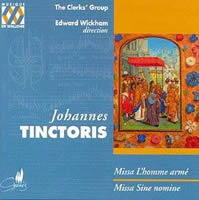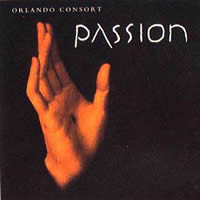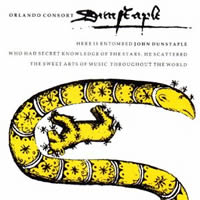A Requiem Done Right
|
Walt Mundkowsky [July 2005.]
Pierre de LA RUE: Requiem (1503?), Missa de Beata Virgine (c. 1500). Ensemble Officium, Wilfried Rombach (cond.). Christophorus CHR 77268 (http://www.christophorus-records.de/). Distributed in the US by Qualiton (http://www.qualiton.com/). A new recording of Pierre de la Rue’s Requiem is for me an event. The last hit in 1991, and was rough rather than good; but then none of Wilfried Rombach’s eight predecessors achieved sweeping success with it. Along with Josquin, Isaac and Brumel, la Rue (c. 1452-1518) belongs in the uppermost rank of Flemish masters who dominated sacred music during the High Renaissance. The prevalent canonic structures and long-breathed lines stamp him as an Ockeghem man, but other emotive and technical factors are also in play. Naturally the requiem form couldn’t bear the full arsenal of la Rue’s invention (the six-voice Missa Ave sanctissima Maria, in strict canon), but within a compact framework one travels quite a distance — complex counterpoint through chant paraphrase and quotation to gorgeous melody, from darkness to eventual light. This disc contains essentially the performance I’ve been hoping for — 12 secure singers, no instruments, a timing of 23:38 (no dawdling but fully cognizant of detail). Rombach gets the key events exactly right. The opening Introitus’ canon is lucidly laid out but pressing, and the great soprano duet at Sicut cervus (a break in the clouds) receives full extension. (La Rue’s duets always represent a “twist of focus,” to borrow Ferneyhough’s term, in the four- or five-part fabric.) Pealing bells in the imitative entries of the Sanctus have never been clearer, nor the Qui tollis of Agnus Dei II more excitingly attacked. And Rombach refuses to distend the matter-of-fact close. Linking the Requiem to a mass showing la Rue’s usual procedures is seldom attempted. To shape that web of imitative entrances (e.g., Beata Virgine’s busy Gloria) into clean, flowing discourse takes a disciplined hand. Rombach can also introduce repose (Agnus Dei) without losing impetus or softening contours. Bo Holten has cited la Rue’s “degree of complexity later only achieved by the European avant-garde around the middle of the [last] century.” La Rue can come off as harder to “read” than his contemporaries because he eschews signposts. Reprises of melody or pulse are continuously altered, and Rombach responds beautifully to these tremors. He also arranges a plenary service by inserting logical chant selections between the movements la Rue composed. Having them delivered by female choristers is anti-historical, but it’s tough to gripe when the intonation and unison ensemble are this immaculate. Sound (captured at the Ev. Kirche Reutlingen-Gönningen) values clarity over ambience, without planting one in the chorus. Ensemble Officium boasts five other Christophorus titles. I’ll gladly sign up — save for the plainchant-plus-saxophone one! Thoughts on previous la Rue Requiems: LPs Konrad Ruhland, Capella Antiqua München Done in a studio in 1965, Ruhland’s was striking enough to get me hooked. His singers (two per part) finished in a hard-boiled 19:00, with instruments called upon to support the basses or lend variety (I recall a squad of buzzing crumhorns in an Agnus Dei). This remained a reference for years, and hearing it in darkened spaces over then-revolutionary Rogers LS3/5a minis and, later, Bedini-amped stacked Quads were prime experiences. Martin Behrmann, Spandauer Kantorei After Ruhland, this seemed ultra-traditional. The Spandauer was an all-purpose academy choir, and a bit unwieldy for the piece. It required a slack 25:00, with distant perspectives. Dietrich Knothe, Capella Lipsiensis This Leipzig cousin of the Spandauer didn’t stick with me. It’s probably quite close in time and approach to the group’s 1966 Ockeghem / Obrecht effort, which I covered here. Berlin Classics brought the la Rue to budget CD a decade ago, and it’s still on Amazon.de and .fr. Charles Ravier, Ensemble Polyphonique de Paris Ravier predated the Ruhland, but couldn’t be taken seriously. With one singer per part and nine players, he turned la Rue into a symphonist. The result was pretty and enticing when overheard from the next room. If only one didn’t know. CDs James Wood, New London Chamber Choir The first version on silver, so I rejoiced. Now it’s another sizable chorus producing a broad, nearly boisterous tone. This may still be available from Musical Heritage Society, which licensed it. Bo Holten, Ars Nova Holten (b. 1948) is a valuable composer as well as conductor of mostly Renaissance repertory. At 29:46, he guides by far the most deliberate rendition on record. Some niceties emerge from the slo-mo scan, and things curiously don’t collapse, though it’s rather like seeing how slowly he can pedal a bicycle without falling off. Still around in Europe. Ensemble Clément Janequin When it appeared in 1989, a definite advance. It had two singers per part, the quickest tempos since Ruhland (21:03), and arresting up-front sound. But despite prominent period-oriented male vocalists, it hasn’t worn especially well. The group can fall into a jogging motion, and the breathless (literally) speeds inspire as much bustle as urgency. A tootling organ accompaniment blurs the sublime Sicut cervus. Three is sometimes a crowd. René Clemencic, Clemencic Consort Clemencic’s La fête de l’âne (The Feast of the Ass, Harmonia Mundi HMC 901036) is unimprovable, sharp rudeness being his métier. Those instincts aren’t greatly moderated here, leaving this a la Rue Requiem like no other. It’s the Ravier angle — more players than singers — pushed well over the top. (With rattling organ interludes and added chants, the ceremony is bloated to 46:51.) Worth hearing, if you like some carnival with your church.
Johannes TINCTORIS: Missa L’homme armé (early 1480s), Missa Sine nomine No. 1 (1470s or ’80s). The Clerks’ Group, Edward Wickham (cond.). Cyprès CYP 3608 (http://www.cypres-records.com/). Distributed in the US by On-Demand Media Services Inc. Cyprès is reissuing this 1999 CD, the only one devoted to Tinctoris (c. 1430-1511). He was the most influential music theorist and critic of his time, writing the first musical dictionary (Terminorum musicae diffinitorium, pre-1475) and treatises on counterpoint, notation, performance practice and recent developments, providing our clearest window on the era. (In Proportionale musices he praised John Dunstaple [c. 1390-1453], and so should we.) Tinctoris also composed, in a learned and expressive style, and these two masses reveal talents not content with judging the output of his peers. Tinctoris scholar Ronald Woodley calls the Missa L’homme armé (four voices, ATTB) the composer’s “most impressive, sustained work.” It of course joins the many settings launched from this popular song, but the text uses tropes (likely by Tinctoris himself) in the Kyrie and Sanctus, and a variant of the Palm Sunday antiphon Pueri hebraeorum at Osanna in excelsis. Long, tortuous lines and piled-up rhythms may recall Ockeghem, but serene episodes sound more individual. (Late in the Gloria, voices paired in unison slowly spread apart, to heart-stopping effect.) The low-flying “nameless” mass is considerably odder, cast in a transposed Dorian mode. (No prior source for its material has been located.) Countertenor, tenor and bass all descend to their depths at times; elsewhere, Tinctoris often loads a single register with activity. Edward Wickham and The Clerks’ Group understand this period as well as any ensemble around. Their superb Ockeghem cycle (which ASV Gaudeamus picked up after one Proudsound disc) began in 1993, years before other outfits jumped on board. (Inclusion of outside names for historical context ran the series to nine CDs.) In 1998, the first of their two and a half discs of Jacob Obrecht (1457/8-1505) helped close another glaring gap. Unlike (say) the Paul Hillier-led Hilliards or The Tallis Scholars, Wickham doesn’t aspire to a seamless tonal blend; each voice (two per part) retains its identity (notably alto Lucy Ballard, who’s rock-solid). Pitch is unwavering, and the layered tempos decisive and pointed. Some would allow lines in the three-voice mass more space to bloom, but Wickham’s energetic slant is brainy and thrilling. It’s curious that a Wickham effort (taped in 1997 at his customary site, St. Andrew’s Church in West Wratting) should find its way to a Belgian label with little history of early-music involvement. (The banner “Musique en Wallonie” explains it.) But this is a distinguished and important release.
Separate Tinctoris items figure in a few CD anthologies, and one of them matters. A Lamentationes Jeremiae set leads off the Orlando Consort’s “Passion” (Metronome MET CD 1015). It’s a late work, printed in 1506 by Petrucci and lasting 9:51 in performance. Little is known of Tinctoris’ last decades, but this adopts an advanced contrapuntal and harmonic idiom. The Orlando is somewhat akin to the present Hilliards (an all-male quartet or more), but with increased edge. “Passion” closely followed their award-winning Dunstaple disc (MET CD 1009). With splendid notes and sound, that belongs on everyone’s early-music shelf. Ronald Woodley’s Tinctoris research is online here.
[More Walt Mundkowsky]
[Previous Article:
Netherlands Winds and Friends]
[Next Article:
The Weiss Resurgence: 3 World Premieres]
|



